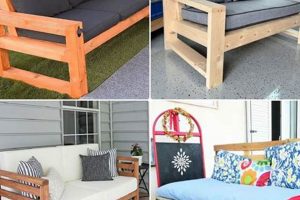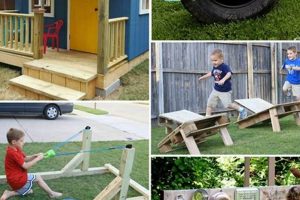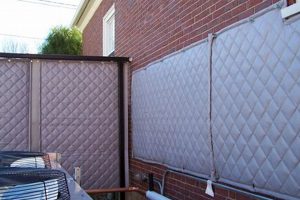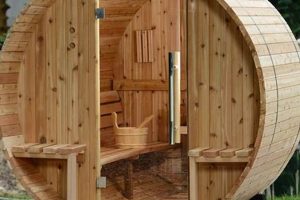The creation of decorative water features for exterior spaces through self-directed construction is a popular home improvement activity. This process involves individuals independently designing and building water fountains intended for outdoor placement, utilizing readily available materials and tools. An example includes constructing a tiered fountain from stacked terracotta pots, a submersible pump, and associated plumbing.
The practice provides an avenue for personalized landscape design and enhancement of outdoor ambiance. It offers cost savings compared to purchasing pre-made fountains and fosters a sense of accomplishment through hands-on project completion. Historically, self-construction projects have allowed homeowners to customize their living spaces to reflect individual tastes and preferences, and this activity fits within that tradition.
The subsequent discussion will delve into crucial aspects of designing, constructing, and maintaining these personalized water features, covering material selection, pump sizing, safety considerations, and preventative maintenance measures to ensure long-term functionality and aesthetic appeal.
Essential Considerations for Constructing Exterior Water Features
The successful implementation of a self-constructed outdoor water feature necessitates careful planning and execution. The following guidelines offer critical insights for a durable and aesthetically pleasing result.
Tip 1: Foundation Stability. Ensure a level and stable foundation for the water feature. Uneven ground can lead to structural instability and potential water leakage. Consider a concrete pad or compacted gravel base, extending beyond the fountain’s footprint, for optimal support.
Tip 2: Pump Selection. Correctly sizing the submersible pump is crucial for appropriate water flow and fountain performance. Calculate the required head pressure (vertical distance the water needs to travel) and flow rate (gallons per hour) to select a pump that meets the fountain’s specific needs. An undersized pump will result in weak flow; an oversized pump may create excessive splashing.
Tip 3: Plumbing Integrity. Utilize durable, weather-resistant plumbing materials, such as PVC or flexible tubing, to connect the pump to the fountain’s water distribution points. Ensure all connections are secure and watertight to prevent leaks and water loss. Consider incorporating unions or quick-disconnect fittings for easier pump maintenance or replacement.
Tip 4: Water Source and Management. Plan for a reliable water source to refill the fountain as needed, accounting for evaporation and potential splashing. Automatic fill systems can maintain a consistent water level. Furthermore, implement strategies to minimize water loss through evaporation, such as shading the fountain during peak sunlight hours.
Tip 5: Filtration and Water Quality. Incorporate a filtration system to remove debris and algae, maintaining water clarity and minimizing pump clogs. Regular cleaning of the filter is essential. Consider using algaecides or beneficial bacteria to further control algae growth and improve water quality.
Tip 6: Electrical Safety. All electrical components must be installed in accordance with local electrical codes. Use a Ground Fault Circuit Interrupter (GFCI) outlet to protect against electrical shock. Bury electrical conduits and connections securely underground to prevent damage from weather or landscaping activities.
Tip 7: Material Durability. Select materials appropriate for outdoor use, considering weather resistance, freeze-thaw cycles, and potential chemical exposure. Stone, concrete, and treated wood are common choices. Avoid materials that are prone to degradation or leaching harmful chemicals into the water.
These considerations highlight the importance of meticulous planning and execution for constructing a functional and aesthetically pleasing outdoor water feature. Proper implementation ensures longevity and minimizes maintenance requirements.
The subsequent section will explore specific design ideas and aesthetic considerations for integrating the water feature seamlessly into the surrounding landscape.
1. Material Durability
Material durability is a paramount concern in the construction of self-built exterior water features. The selection of appropriate materials directly influences the lifespan, maintenance requirements, and overall aesthetic appeal of these installations.
- Resistance to Freeze-Thaw Cycles
In regions experiencing significant temperature fluctuations, materials must withstand repeated freezing and thawing. Water expansion within porous materials can lead to cracking and disintegration. Dense, non-porous options such as certain types of stone, high-density concrete, and specific polymers exhibit superior resistance compared to materials like terracotta or untreated wood. The implications for failing to consider this are costly repairs or complete replacement of the structure.
- Weather Resistance and UV Degradation
Prolonged exposure to sunlight, rain, and wind can degrade materials over time. Ultraviolet (UV) radiation from the sun can cause fading, discoloration, and embrittlement of certain plastics and finishes. Selecting materials with inherent UV resistance or applying protective coatings is crucial. For instance, marine-grade stainless steel or powder-coated aluminum offer better corrosion resistance than untreated steel. Failure to address this leads to aesthetic decline and potential structural weakening.
- Chemical Stability in Aquatic Environments
Materials in direct contact with water are susceptible to chemical reactions and leaching. Some materials may release harmful chemicals into the water, affecting plant and aquatic life, or corrode due to prolonged immersion. Inert materials like certain types of stone, sealed concrete, and specific plastics suitable for aquatic use are preferable. Copper, for example, should be avoided in systems intended to support fish due to its toxicity. Choosing inappropriate materials can harm the ecosystem of the fountain and its surroundings.
- Resistance to Microbial Growth
Outdoor water features are prone to microbial growth, including algae and bacteria. Some materials are more susceptible to biofilm formation and staining, requiring more frequent cleaning and maintenance. Non-porous, smooth surfaces are generally easier to clean and less hospitable to microbial colonization. Antimicrobial additives can also be incorporated into certain materials to inhibit growth. Neglecting this can result in an unsightly and potentially unhealthy environment.
In summation, material durability is inextricably linked to the long-term success of any independently constructed outdoor water feature. Careful consideration of these factors, including climate conditions, water chemistry, and potential microbial activity, is essential for ensuring a lasting, functional, and visually pleasing addition to the landscape.
2. Pump Performance
The operational efficacy of any self-constructed outdoor water feature is intrinsically linked to the performance characteristics of the submersible pump. Inadequate pump selection directly translates to diminished aesthetic appeal and compromised functionality. Water flow rate, head pressure capacity, and energy efficiency constitute the key parameters defining performance. A pump with insufficient flow rate will produce a weak, underwhelming water display, failing to achieve the intended visual impact. Conversely, an improperly sized pump can consume excessive energy, leading to increased operational costs and potential equipment failure. For example, a tiered fountain design necessitates a pump with adequate head pressure to elevate water to the uppermost tier. Failure to accurately assess this requirement will result in inadequate water distribution and an incomplete display. Practical understanding of pump curves and performance specifications is therefore essential for successful project execution.
Effective pump performance management extends beyond initial selection. Regular maintenance, including cleaning debris from the pump intake and ensuring proper water level, is crucial for sustained operational efficiency. Mineral buildup and sediment accumulation can impede water flow and reduce pump lifespan. Incorporating a pre-filter system can mitigate these issues, extending the pump’s operational life and reducing maintenance frequency. Furthermore, the integration of variable speed controllers allows for customized water flow adjustments, optimizing the aesthetic display and conserving energy. This active management contributes significantly to the longevity and efficiency of the water feature.
In conclusion, the connection between submersible pump performance and the overall success of a custom outdoor water feature cannot be overstated. Precise pump selection based on design parameters, coupled with proactive maintenance and operational optimization, are critical for achieving the desired aesthetic effect, ensuring energy efficiency, and maximizing the lifespan of the system. Neglecting these aspects ultimately diminishes the visual appeal, increases operational costs, and shortens the functional lifespan of the entire project. The pump is, therefore, the functional heart of any “outdoor water fountain diy” venture.
3. Foundation Stability
Foundation stability is a critical element in the successful construction and long-term maintenance of any independently built outdoor water feature. The integrity of the base upon which the fountain rests directly impacts its structural integrity, operational efficiency, and aesthetic presentation. Failure to adequately address foundation requirements can lead to a cascade of problems, ultimately compromising the entire project.
- Load-Bearing Capacity and Soil Compaction
The foundation must possess sufficient load-bearing capacity to support the combined weight of the fountain structure, the water it contains, and any decorative elements. Soil compaction is a critical factor, as unstable or poorly compacted soil can settle over time, leading to tilting or structural failure. For example, a multi-tiered stone fountain filled with hundreds of gallons of water will exert significant pressure on the underlying ground. Proper compaction, potentially with the addition of a gravel base or a concrete pad, is essential to distribute the load evenly and prevent settling. The implications of neglecting this can range from minor aesthetic distortions to catastrophic structural collapse.
- Leveling and Horizontal Alignment
Precise leveling and horizontal alignment are crucial for ensuring uniform water distribution and preventing uneven stress on the fountain structure. An unlevel foundation will cause water to overflow unevenly, disrupting the intended visual effect. Moreover, it can create stress points within the structure, leading to cracking or other forms of damage. The use of surveying equipment or a spirit level is essential to establish a perfectly level base before construction begins. For instance, even a slight slope in the foundation can result in noticeable water imbalances and accelerated wear on the lower side of the structure. This requirement is particularly important for complex fountain designs with intricate water features.
- Resistance to Frost Heave and Ground Movement
In regions subject to freezing temperatures, the foundation must be designed to resist frost heave, which is the upward swelling of soil due to the formation of ice. Frost heave can exert tremendous pressure on the foundation, causing it to crack or shift. Constructing a foundation that extends below the frost line or incorporating insulating materials can mitigate this risk. Similarly, the foundation must be able to withstand other forms of ground movement, such as those caused by seismic activity or expansive clay soils. A reinforced concrete pad or a flexible foundation system can provide the necessary stability in these conditions. Failure to account for these factors can lead to significant structural damage and costly repairs.
- Drainage and Water Runoff Management
Proper drainage is essential to prevent water from accumulating around the foundation, which can weaken the soil and contribute to instability. The foundation should be designed to promote effective water runoff, diverting water away from the base of the fountain. This can be achieved through the use of sloping surfaces, drainage channels, or permeable materials. For example, incorporating a gravel apron around the fountain can help to absorb excess water and prevent soil erosion. Inadequate drainage can lead to water damage, soil instability, and increased maintenance requirements.
These considerations highlight the integral connection between foundation stability and the long-term success of any self-constructed outdoor water feature. Proper site preparation, careful construction techniques, and appropriate material selection are all essential for ensuring a stable and durable foundation that will support the fountain for years to come. The foundation is not merely a base, but a critical component of the overall system, directly influencing its functionality, aesthetics, and longevity.
4. Water Management
Effective water management is paramount for the functionality and sustainability of independently constructed outdoor water features. The design and implementation of a system for efficient water use, conservation, and control directly influences the fountain’s visual appeal, operational costs, and environmental impact. Failure to address water management comprehensively can lead to excessive water loss, increased maintenance requirements, and potential damage to surrounding landscaping. Consider, for instance, a multi-tiered fountain lacking adequate measures to mitigate evaporation; it would require frequent refilling, leading to higher water bills and potential strain on local water resources. A well-designed water management system, conversely, promotes responsible water usage and minimizes environmental consequences.
Strategies for optimized water management in self-built water features encompass several key areas. These include implementing automatic fill systems to maintain consistent water levels and prevent pump damage from running dry; incorporating filtration systems to remove debris and algae, thereby reducing the need for frequent water changes; and utilizing water-conserving pump technologies that minimize energy consumption and water wastage. Additionally, landscape design can play a crucial role. Strategically planting vegetation around the fountain can provide shade, reducing evaporation rates, and creating a more natural, water-efficient ecosystem. The choice of materials for the fountain’s construction also impacts water management; non-porous surfaces minimize water absorption and reduce water loss through seepage. Practical application of these techniques significantly extends the time between refills and reduces the environmental footprint of the feature.
In conclusion, the integration of robust water management principles is essential for the long-term viability of any do-it-yourself outdoor water fountain project. A comprehensive approach, encompassing efficient water use, conservation strategies, and proactive maintenance, ensures that the fountain remains a visually appealing and environmentally responsible addition to the landscape. Neglecting water management not only compromises the fountain’s aesthetic value but also results in increased operational costs and detrimental environmental impacts. Therefore, thoughtful planning and execution of a water management system are critical for maximizing the benefits and minimizing the drawbacks of a self-constructed water feature.
5. Electrical Safety
Electrical safety is a non-negotiable aspect of designing and implementing outdoor water features through self-directed projects. The proximity of water and electricity inherently presents significant risks, necessitating strict adherence to safety protocols and code compliance. Neglecting electrical safety can result in severe injury or death, highlighting the critical importance of understanding and mitigating potential hazards.
- Ground Fault Circuit Interrupters (GFCIs)
GFCIs are essential safety devices that monitor the current flow in a circuit. If a ground fault is detectedindicating that electricity is leaking along an unintended path, such as through a personthe GFCI rapidly cuts off power to the circuit, preventing electrocution. All electrical outlets and wiring associated with the water feature must be GFCI-protected. For example, if a submersible pump develops a fault and begins leaking current into the water, the GFCI will trip, interrupting the power supply before a person touching the water is harmed. Installation of GFCIs is a code requirement and a fundamental safety measure.
- Proper Grounding and Bonding
Grounding involves connecting electrical equipment to the earth through a grounding conductor, providing a low-resistance path for fault current to flow back to the source. Bonding electrically connects metallic parts of the water feature to ensure they are at the same electrical potential. This prevents voltage differences that could create a shock hazard. For instance, if a metal fountain structure becomes energized due to a wiring fault, proper bonding will ensure that any person touching it does not experience a dangerous voltage difference relative to the ground. Grounding and bonding are crucial for minimizing shock hazards and ensuring the safe operation of the electrical system.
- Weather-Resistant Wiring and Conduit
All wiring and electrical connections must be rated for outdoor use and protected from the elements. Direct burial cable (UF cable) and waterproof connectors are necessary for underground installations. Conduit, such as PVC or rigid metal conduit, provides physical protection for wiring from damage due to moisture, abrasion, and impact. For example, using standard indoor wiring in an outdoor environment will quickly lead to deterioration of the insulation, creating a shock hazard and potentially causing a short circuit. Proper weather-resistant materials are essential for ensuring the long-term reliability and safety of the electrical system.
- Professional Inspection and Compliance
While constructing a water feature may be a do-it-yourself project, electrical work should ideally be performed by a qualified electrician. A professional can ensure that all wiring is installed correctly, meets local electrical codes, and is safe for operation. Even if the electrical work is performed independently, it is advisable to have it inspected by a qualified electrician before the water feature is put into service. Code compliance is not merely a formality; it is a set of safety standards designed to protect individuals from electrical hazards. Ignoring code requirements can have serious consequences.
The integration of these electrical safety measures is not an optional component but a mandatory requirement for any self-built outdoor water fountain. Prioritizing safety throughout the design, installation, and maintenance phases is paramount. Engaging qualified professionals, adhering to code requirements, and utilizing appropriate materials are essential for preventing electrical hazards and ensuring a safe and enjoyable water feature experience.
Frequently Asked Questions
The following section addresses common inquiries and concerns regarding the planning, construction, and maintenance of water features for outdoor spaces, constructed independently.
Question 1: What is the optimal depth for a fountain basin designed to house aquatic plants?
The optimal basin depth varies depending on the specific plant species. However, a general guideline is to maintain a depth of at least 18 inches to accommodate root systems and provide adequate water volume for temperature stability. Shallow-water plants may thrive in depths of 6-12 inches, while deeper-water varieties require 24 inches or more.
Question 2: How frequently should a fountain pump be cleaned to maintain optimal performance?
Pump cleaning frequency depends on environmental factors, such as debris accumulation and algae growth. A general recommendation is to inspect and clean the pump at least once a month during peak operating season. If the fountain is located near trees or other sources of debris, more frequent cleaning may be necessary.
Question 3: What type of sealant is best suited for preventing leaks in a concrete fountain structure?
A sealant specifically designed for concrete and aquatic environments is crucial. Epoxy-based sealants or those formulated with polyurethane offer superior adhesion and water resistance. Ensure the sealant is non-toxic and safe for aquatic life if the fountain will house plants or animals.
Question 4: What precautions should be taken to winterize an outdoor fountain in cold climates?
Winterizing involves several steps to prevent damage from freezing temperatures. The fountain should be completely drained of water. The pump should be removed, cleaned, and stored indoors. The fountain structure itself should be covered with a protective tarp or material to prevent cracking from ice expansion.
Question 5: How can algae growth be effectively controlled in an outdoor fountain without harming aquatic plants?
Algae growth can be managed through a combination of strategies. Regularly cleaning the fountain, maintaining proper water circulation, and using beneficial bacteria or algaecides specifically formulated for aquatic plants are effective methods. Avoid over-exposure to direct sunlight, which promotes algae growth.
Question 6: What is the recommended method for securing a fountain to its base to prevent tipping or movement?
The method for securing a fountain depends on its size, weight, and the type of base material. For lighter fountains, construction adhesive may suffice. Heavier fountains may require mechanical fasteners, such as bolts or anchors, to securely attach the fountain to a concrete pad or other stable base. Ensure the fasteners are corrosion-resistant.
These frequently asked questions provide essential guidance for ensuring the successful implementation and maintenance of independent water feature projects. Adherence to these recommendations contributes to the longevity and aesthetic appeal of the installation.
The following section will explore advanced design techniques and customization options for water features.
Conclusion
The preceding exploration of “outdoor water fountain diy” has detailed essential considerations, ranging from foundational stability and material durability to electrical safety and optimized water management. These factors critically influence the functionality, aesthetic appeal, and longevity of self-constructed water features. Careful planning and meticulous execution are paramount.
The information presented serves as a foundation for informed decision-making in independent construction endeavors. Success hinges on adherence to safety protocols, meticulous planning, and a thorough understanding of the principles outlined. The creation of lasting and visually appealing water features depends on such diligent application.







